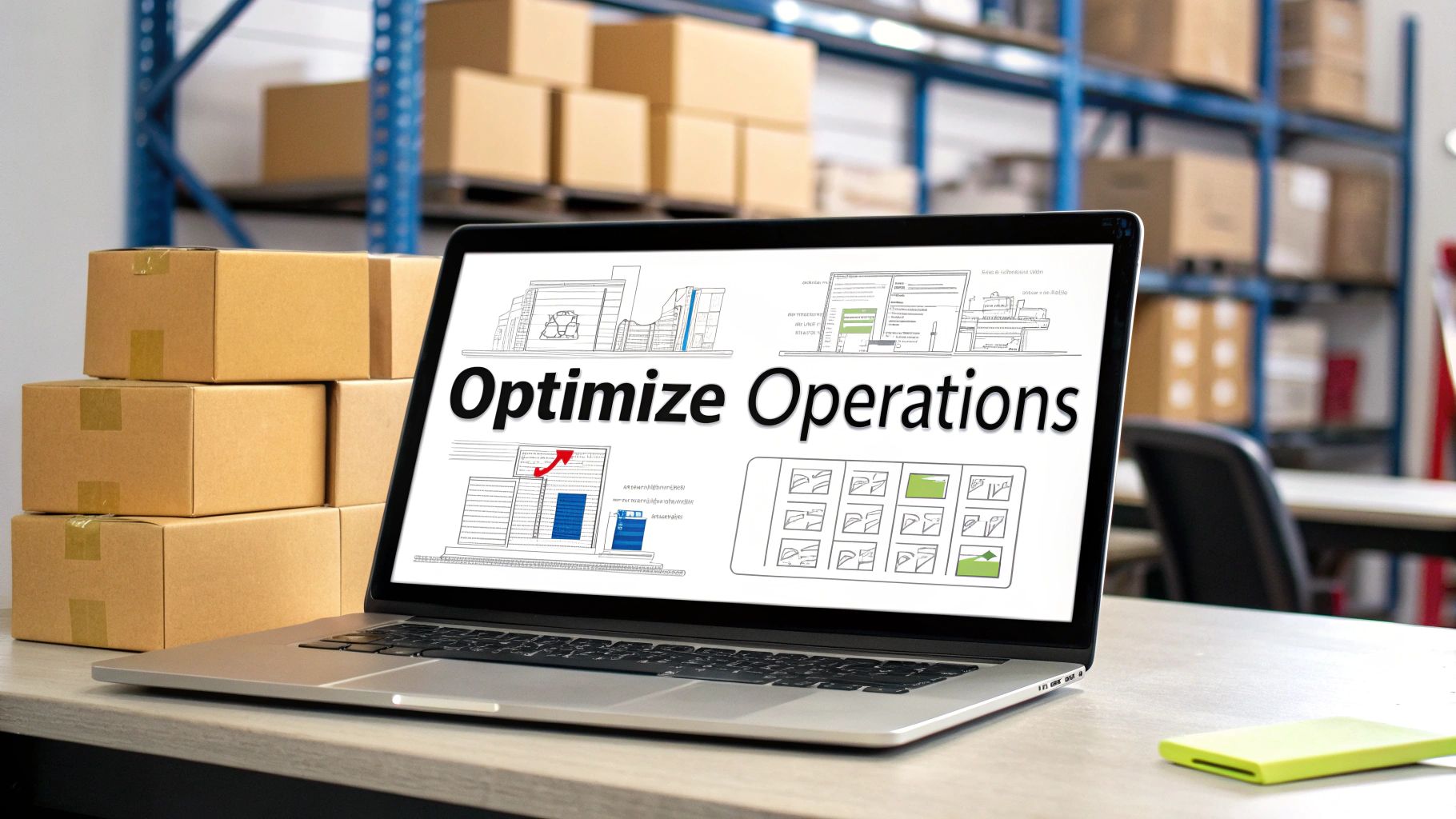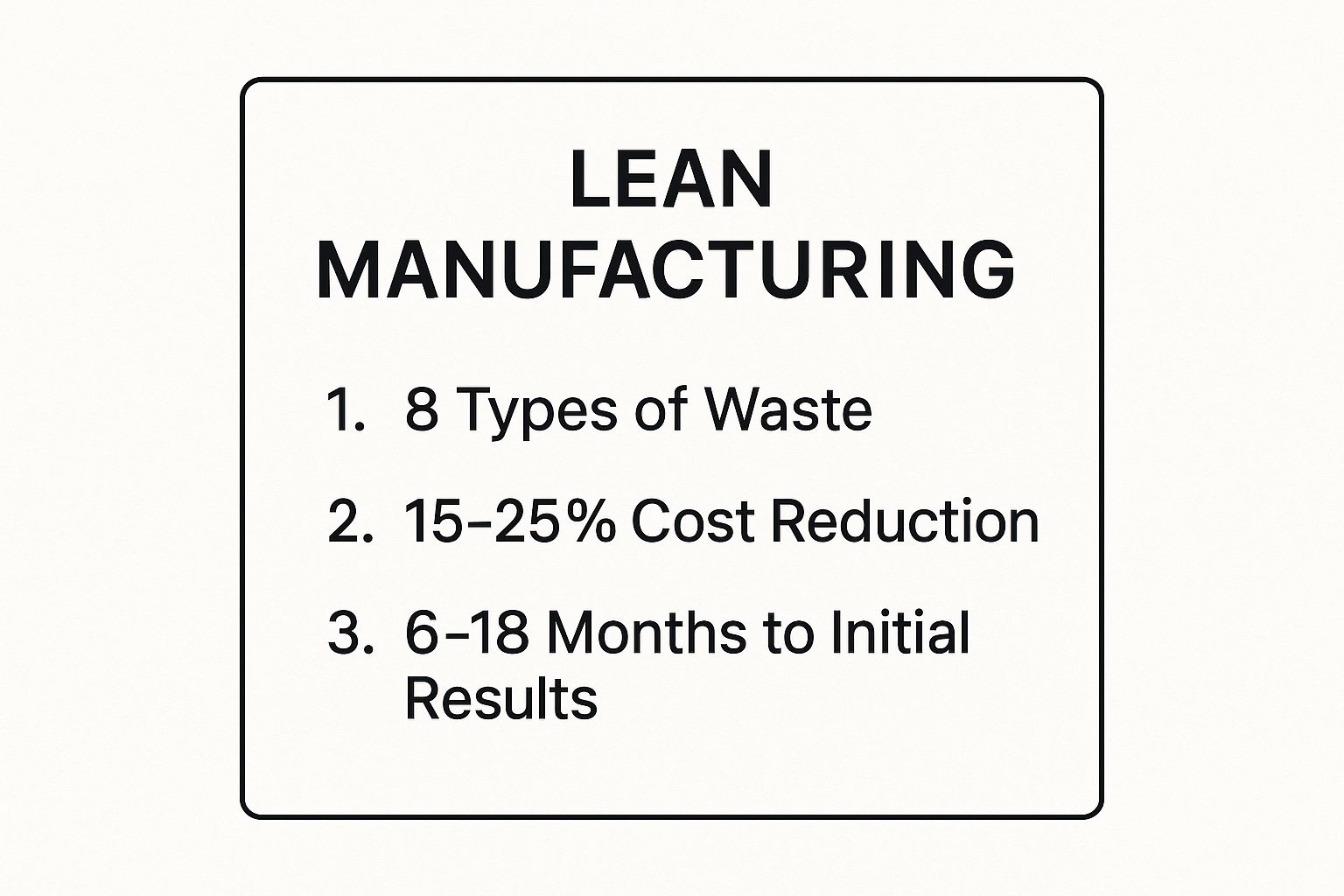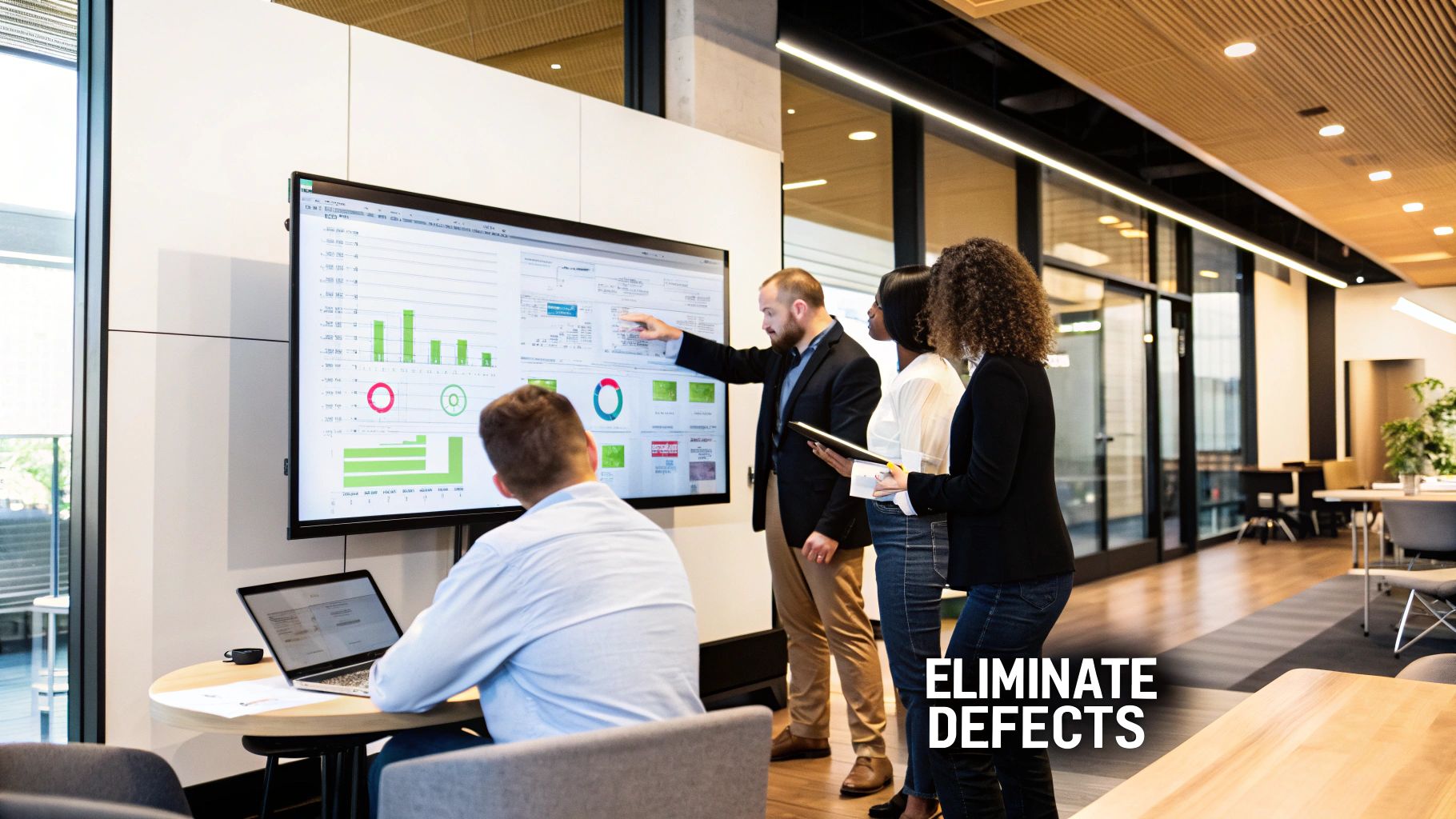Stay Updated with Everything about MDS
Thank you! Your submission has been received!
Oops! Something went wrong while submitting the form.

Chilat Doina
October 6, 2025
In the competitive world of e-commerce, efficiency isn't just a goal; it's a critical component of survival and growth. As an Amazon seller or brand owner, you're constantly juggling inventory management, order fulfillment, marketing campaigns, and customer service. Each of these areas contains complex workflows, and even minor inefficiencies can compound over time, leading to wasted resources, increased costs, and missed opportunities. This is where a systematic approach to operational enhancement becomes invaluable.
This guide moves beyond generic advice to provide a comprehensive roundup of nine powerful business process improvement techniques. We will explore proven methodologies like Lean, Six Sigma, and Kaizen, breaking them down into actionable steps tailored for the unique challenges of an e-commerce environment. You will learn not just the "what" but the "how" behind each strategy, with practical examples demonstrating their application, from streamlining your supply chain to optimizing your listing creation process.
Ultimately, mastering these frameworks allows you to do more with less. By identifying and eliminating waste, reducing errors, and creating more consistent, reliable workflows, you can scale your operations sustainably. A key application of these methods is understanding how to boost your team's effectiveness in crucial areas, such as improving sales productivity within your organization. The goal is to build a more resilient, agile, and profitable business by transforming your core processes from liabilities into strategic assets. Let's dive into the techniques that can make it happen.
Lean Manufacturing is a powerful and systematic business process improvement technique that focuses on a single core principle: maximizing customer value while relentlessly eliminating waste. Originally developed as the Toyota Production System, this methodology is now used across industries to create more efficient, agile, and customer-centric operations. It achieves this by identifying and removing any activity that consumes resources but adds no value to the final product or service.
At its heart, Lean targets the "eight wastes" or muda: overproduction, waiting, unnecessary transportation, over-processing, excess inventory, unnecessary motion, defects, and untapped human potential. For an Amazon seller, this could mean reducing excess inventory that ties up capital, streamlining the pick-and-pack process to eliminate wasted motion, or cutting down on time spent waiting for supplier shipments. The goal is a continuous flow of value from your business to your customer, with minimal friction or inefficiency.
Lean is not just about cutting costs; it's a holistic philosophy for operational excellence. By focusing on waste elimination, you inherently improve quality, shorten cycle times, and become more responsive to customer demand. For e-commerce brands, this translates into faster fulfillment, fewer order errors, and lower operational overhead. It forces you to scrutinize every step of your value chain, from sourcing raw materials to the final delivery confirmation.
Successfully adopting Lean requires a structured approach and commitment from your entire team.
Here’s a quick reference summarizing the key data points associated with Lean implementation.

This data highlights Lean's significant potential for cost savings and underscores that while initial results can be seen within months, it is a long-term commitment to continuous improvement. If you're looking for ways to streamline your operations from top to bottom, explore how to improve operational efficiency with Lean principles.
Six Sigma is a highly disciplined, data-driven business process improvement technique designed to eliminate defects and minimize variability. Popularized by Motorola and championed by GE's Jack Welch, its ultimate goal is to achieve near-perfection by limiting defects to just 3.4 per million opportunities. It achieves this through a rigorous framework known as DMAIC (Define, Measure, Analyze, Improve, Control) and a heavy reliance on statistical analysis.
For an e-commerce brand, Six Sigma could be used to drastically reduce the number of incorrect items shipped, pinpoint the root cause of frequent product returns, or optimize customer service response times to be highly consistent. By focusing on measurable data, it moves process improvement from guesswork to a statistical science, ensuring that changes are both effective and sustainable. The methodology systematically uncovers the hidden causes of errors that erode profits and customer satisfaction.

Six Sigma’s power lies in its relentless focus on quality and consistency. While Lean targets waste, Six Sigma targets defects and variability, making them complementary partners in operational excellence. For an Amazon seller, this translates into higher product review ratings, lower return rates, and a stronger brand reputation built on reliability. By reducing process variation, you ensure a consistent and predictable customer experience every single time an order is placed.
Adopting Six Sigma requires a commitment to data and a structured, project-based approach.
Kaizen, a Japanese term meaning "change for the better" or "continuous improvement," is a powerful business process improvement technique centered on making small, incremental changes consistently over time. Rather than pursuing massive, disruptive overhauls, Kaizen promotes a culture where all employees, from the warehouse floor to executive leadership, are actively engaged in identifying and implementing small improvements in their daily work. This philosophy builds momentum and creates a culture of perpetual optimization.

At its core, Kaizen is about harnessing the collective intelligence of the entire organization. For an e-commerce brand, this could mean a fulfillment associate suggesting a better way to organize packing stations to save a few seconds per order, or a customer service agent proposing a small tweak to an email template to reduce confusion. Companies like Toyota famously implement over a million Kaizen suggestions annually, demonstrating the immense power of compounding small, positive changes.
Kaizen is a top technique because it empowers employees and makes improvement a shared responsibility, not just a top-down mandate. It fosters engagement and ownership, as team members see their ideas directly improving the workplace. This approach is less intimidating than large-scale projects and can deliver significant long-term gains in efficiency, quality, and morale. For an Amazon seller, this translates to a more adaptable and proactive operation that can quickly pivot and refine processes without major disruption.
Adopting a Kaizen culture requires a systematic approach to encourage, capture, and implement ideas.
Business Process Reengineering (BPR) is a radical and ambitious business process improvement technique that involves fundamentally rethinking and redesigning core processes from the ground up. Unlike methods that focus on incremental improvements, BPR advocates for a "clean slate" approach to achieve dramatic gains in critical performance measures like cost, quality, service, and speed. It asks not "How can we do this better?" but "Why do we do this at all?"
Pioneered by thinkers like Michael Hammer and James Champy, BPR challenges long-held assumptions about how work gets done. For an e-commerce brand, this isn't about slightly tweaking your vendor onboarding; it’s about completely redesigning the entire procurement and inventory management system. Instead of multiple departments handling purchase orders, receiving, and invoicing separately, BPR might consolidate these tasks into a single, technology-enabled process, dramatically reducing handoffs and delays.
BPR is a top-tier strategy for businesses needing a breakthrough rather than just a small step forward. It forces a complete reevaluation of your operations with a laser focus on customer value. By eliminating outdated processes and leveraging technology, companies can achieve quantum leaps in efficiency and effectiveness. This approach is ideal for businesses facing significant market disruption or those whose existing processes are so broken that minor adjustments are insufficient.
Implementing BPR is a high-stakes initiative that requires careful planning and unwavering executive support.
BPR is a powerful tool for transformative change. For instance, successfully reengineering your supply chain requires a deep dive into how you work with suppliers. Exploring best practices in vendor management can provide critical insights for this type of large-scale redesign.
Agile Methodology is an iterative and collaborative business process improvement technique that prioritizes flexibility, customer feedback, and incremental progress. Originally rooted in software development, its principles are now widely adopted across various business functions to manage complex projects and adapt to rapid market changes. Instead of a single, long-term plan, Agile breaks down large initiatives into small, manageable cycles called "sprints," allowing teams to deliver value quickly and adjust course based on real-world results.
At its core, Agile fosters a culture of continuous delivery and learning. For an e-commerce brand, this could mean launching a new product feature in small stages, gathering customer feedback after each release, and using that input to guide the next development sprint. This approach minimizes the risk of building something customers don't want and ensures that process improvements are constantly aligned with business goals and market demands.
Agile's power lies in its adaptability. In the fast-paced world of e-commerce, market trends, customer preferences, and platform algorithms can change overnight. Agile provides the framework to respond to these changes effectively, rather than being locked into a rigid, outdated plan. This leads to faster project completion, higher quality outcomes, and a team that is more engaged and responsive. It shifts the focus from rigid processes to delivering tangible value to the customer in every cycle.
Adopting Agile requires a mindset shift towards collaboration and iterative improvement. To fully grasp the power of this approach, it's beneficial to explore various aspects of Agile project management methodologies.
Total Quality Management (TQM) is a holistic business process improvement technique centered on achieving long-term success through customer satisfaction. It operates on the principle that every employee, from the C-suite to the warehouse floor, is responsible for maintaining high quality standards. Unlike methods that focus on inspecting final products, TQM integrates quality control into every stage of the business process.
At its core, TQM is a cultural shift that embeds continuous improvement into the organization's DNA. For an e-commerce brand, this means obsessing over every customer touchpoint, not just the product itself. This could involve ensuring product listings are perfectly accurate, customer service interactions are flawless, and packaging provides an excellent unboxing experience. The goal is to build a system where quality is the default outcome, leading to fewer defects, reduced costs, and enhanced customer loyalty.
TQM is powerful because it reframes quality from a departmental task to a company-wide commitment. By focusing on customer satisfaction as the ultimate goal, it aligns every operational activity toward a single, unified purpose. This approach proactively prevents errors rather than just reacting to them, which builds a strong brand reputation and reduces the high costs associated with returns, rework, and negative reviews. For an Amazon seller, consistently high quality leads to better reviews, a lower Order Defect Rate (ODR), and improved search ranking.
Implementing TQM requires a systematic, top-down approach that permeates the entire organization.
Value Stream Mapping (VSM) is a foundational business process improvement technique and a core component of Lean methodology. It's a visual tool used to analyze and improve the flow of materials and information required to bring a product from its origin to the customer. By creating a detailed map of every action and piece of information, VSM exposes waste and highlights opportunities for radical improvement that might otherwise go unnoticed.
The power of VSM lies in its ability to visualize the entire process, not just isolated parts. For an e-commerce brand, this means charting every step from a customer placing an order to the product arriving at their door, including all supplier interactions, warehouse movements, and data exchanges. This comprehensive view helps identify bottlenecks, delays, and non-value-added activities, allowing you to design a more efficient "future state" process. For example, Amazon reportedly used VSM to help reduce order fulfillment time by 25%.
Value Stream Mapping is one of the most effective techniques for understanding the big picture of your operations. Instead of making small, disconnected tweaks, VSM provides a strategic roadmap for transformation. It moves process improvement from guesswork to a data-driven exercise, clearly showing where your most significant problems lie. For brand owners, this means you can prioritize improvements that will have the biggest impact on speed, cost, and customer satisfaction.
Implementing VSM requires a hands-on, collaborative approach to accurately capture how work is truly done.
VSM is a powerful diagnostic tool that forms the basis for many other improvement initiatives. To see how it fits into a broader strategy, consider the principles outlined in the book that popularized the method, Learning to See.
Kanban is a highly visual and effective business process improvement technique designed to manage workflow, limit work-in-progress (WIP), and maximize efficiency. Originating from the Toyota Production System, this method uses a Kanban board with columns and cards to create a visual representation of your entire process. Each card represents a task, and each column signifies a stage in the workflow, allowing teams to see bottlenecks and manage capacity in real-time.
At its core, Kanban is about creating a smooth, continuous flow of work. For an e-commerce brand, this could mean visualizing the new product development pipeline, from initial idea to market launch. A card for a "new summer apparel line" would move across columns like "Concept," "Design," "Sourcing," "Manufacturing," and "Marketing Launch." This visual system makes it immediately obvious where work is piling up, preventing teams from starting new tasks before finishing existing ones.
Kanban excels at improving visibility and promoting focus. Instead of relying on spreadsheets or verbal updates, everyone can see the status of every task at a glance. This transparency fosters collaboration and empowers teams to self-manage their workload. For Amazon sellers managing multiple projects like PPC campaign launches, new product photography, and inventory restocking, Kanban provides a centralized command center to prevent overload and ensure critical tasks don't get missed.
Getting started with Kanban is straightforward and doesn't require a disruptive overhaul of your current processes.
Plan-Do-Check-Act (PDCA), often called the Deming Cycle, is a foundational iterative model for continuous improvement. This four-step management method provides a simple yet powerful scientific framework for testing hypotheses, solving problems, and implementing changes in a controlled way. It’s a cyclical process designed to foster ongoing improvement rather than one-time fixes.
At its core, PDCA is about systematic learning and adaptation. An Amazon seller could use it to test a new packaging method to reduce shipping damage. They would Plan the change, Do a small-scale trial run, Check the results by analyzing damage rates, and Act by either implementing the new method across all shipments or refining the plan for another cycle. This structured approach minimizes risk and ensures that decisions are based on data, not assumptions.

PDCA is one of the most versatile business process improvement techniques because of its simplicity and universal applicability. It can be used for anything from minor adjustments in your customer service script to major overhauls of your inventory management system. It builds a culture of critical thinking and problem-solving, empowering your team to identify issues and test solutions methodically. For e-commerce brands, this means a reliable way to enhance processes, improve product quality, and boost customer satisfaction step-by-step.
Adopting the PDCA cycle involves embracing its four distinct phases and committing to the iterative process.
Navigating the competitive landscape of e-commerce, especially on a platform as dynamic as Amazon, requires more than just a great product. It demands operational excellence. The journey through these powerful business process improvement techniques, from the waste-eliminating principles of Lean to the iterative cycles of Agile and PDCA, provides a comprehensive toolkit for achieving that excellence.
You've explored a range of methodologies, each offering a unique lens through which to view and refine your operations. Whether it's the radical transformation promised by Business Process Reengineering or the incremental, continuous improvement championed by Kaizen, the underlying theme is a commitment to evolution. These aren't just theoretical frameworks; they are practical, actionable roadmaps for building a more resilient, efficient, and profitable brand.
As you move forward, keep these core principles at the forefront of your strategy:
Feeling inspired is one thing; taking action is what separates thriving businesses from stagnant ones. Don't let the sheer number of options lead to paralysis. Instead, start small and build momentum.
By systematically applying these proven frameworks, you move from a reactive "firefighting" mode to a proactive state of strategic control. You stop being a victim of operational bottlenecks and become the architect of a streamlined, scalable, and highly competitive e-commerce machine. The path to operational mastery is built one improved process at a time.
Ready to surround yourself with peers who are mastering these very techniques? The Million Dollar Sellers community is an exclusive mastermind for elite Amazon sellers who share cutting-edge strategies for scaling operations, optimizing processes, and dominating the marketplace. Learn more and see if you qualify to join the conversation at Million Dollar Sellers.
Join the Ecom Entrepreneur Community for Vetted 7-9 Figure Ecommerce Founders
Learn MoreYou may also like:
Learn more about our special events!
Check Events